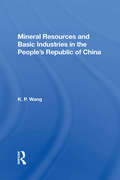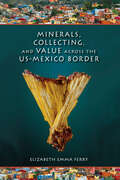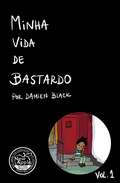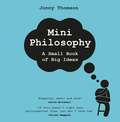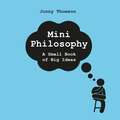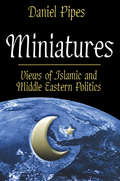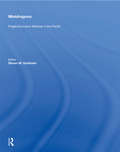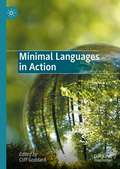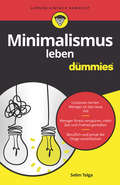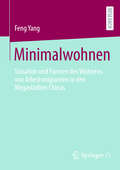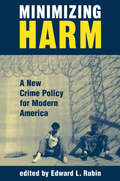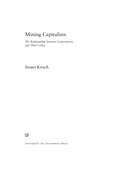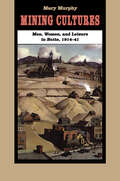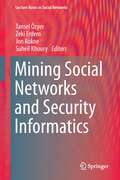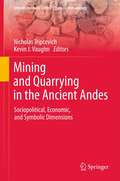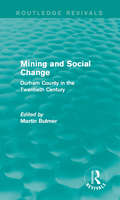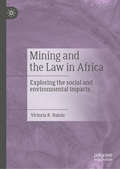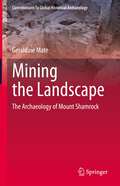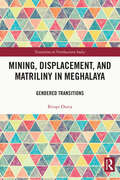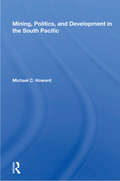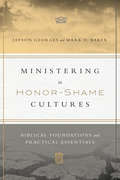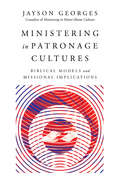- Table View
- List View
Mineral Resources and Basic Industries in the People's Republic of China
by K.P. WangFirst published in 1977. Mining and metallurgy have had a long history in China, and resources there have always been considered promising. More recently, in the People's Republic of China (PRC), a remarkable industrial renaissance is underway that should gain further momentum in the years ahead. Rapid development of minerals has brought the PRC prominence not only in the area of industrialization, but also in world affairs. Chinese mineral developments, especially in petroleum, have been increasingly in the news. A very large coal industry is already in existence. The steel industry ranks fifth or sixth in the world. The PRC is also prominent in fertilizer, cement, and salt production, and its export metals are well known. The need to know about Chinese mineral developments and the intense interest in them have prompted Dr. Wang's study. Emphasizing the world significance of Chinese minerals, he reviews the history of growth in the PRC' s mineral industry and its present supply position; evaluates policy considerations and regional technical factors affecting mineral development; and assesses the PRC's mineral trade and its efforts to obtain equipment, supplies, and new technology.
Minerals, Collecting, and Value across the US-Mexico Border
by Elizabeth Emma Ferry“A jewel to those interested in ore mining, mineral collecting and mineralogy, or the anthropology of value.” —American EthnologistAnthropologist Elizabeth Emma Ferry traces the movement of minerals as they circulate from Mexican mines to markets, museums, and private collections on both sides of the United States-Mexico border. She describes how and why these byproducts of ore mining come to be valued by people in various walks of life as scientific specimens, religious offerings, works of art, and luxury collectibles. The story of mineral exploration and trade defines a variegated transnational space, shedding new light on the complex relationship between these two countries—and on the process of making value itself.“A novel contribution to the anthropology of natural resources.” —Journal of Latin American and Caribbean Anthropology“Highly recommended.” —Choice
Mines and Miners of Cornwall and Devon: The Tin and Copper Industries
by Anthony BurtonThe eminent historian and author of The Rise of King Cotton uncovers the centuries-old story of tin mining in Southern England.Tin mining has existed in Cornwall and parts of Devon since before the Romans arrived in Britain. In this book, historian Anthony Burton explores the region’s tin mining industry from its earliest period through to the present day.A specialist in the history of technology, Burton examines the evolution of extraction methods from primitive pick and shovel operations to the later use of explosives, the rise of steam power, and beyond. Burton also looks at the changing politics and economics of the tin mining industry over the centuries.
Minha Vida de Bastardo
by Damien Black"Uma história da maioridade no sistema Foster Care de Nova York" Minha vida de bastardo vol. 1 “Minhas lembranças desse período são muitas vezes nebulosas. Eles se dobram e se deformam como nuvens presas entre duas frentes. Muitas coisas terríveis me aconteceram que tento não lembrar, mas eu era criança, eu era inocente e costumava ser feliz às vezes. " Nascido no bairro espanhol, Harlem em 1972, filho de uma mãe adolescente, porto-riquenha e de pai negro, Javier Soto é um defeito na sociedade americana. Depois de um incêndio que foi feito por sua mãe, enquanto seu pai cumpria pena na prisão, Javier e suas irmãs são removidos de sua casa para um sistema que se assemelha a um orfanato. Esta verdadeira história da vida de Javier Soto leva você na jornada emocionante de um menino que fica sob a custódia de um mundo brutal. Começando no Catholic Home Bureau (uma das instituições que usam o sistema Foster Care) o conto de Javier retrata a evolução de uma criança inocente para se transformar em um adolescente enfurecido, enfrentando os perigos do abuso, da fome e da negligência. Como milhares de crianças americanas que são levadas para a rede de assistência social, Javier e suas irmãs são repetidamente arrastados por vários lares adotivos, cada um menos acolhedor do que o anterior. Depois que Javier foi separado de suas irmãs, é deixado para continuar sua cruzada de sobrevivência sozinho. Um relato indelével que conta a angústia de um menino, sua auto-aversão e um desejo insatisfeito de amor, que é o direito de nascimento de cada criança. Com tão pouca razão para ter esperança, até onde vai Javier?
Mini Philosophy: A Small Book of Big Ideas
by Jonny Thomson'Engaging, smart and wise, Mini-Philosophy is a diverse taster menu of ideas on life, the mind and the world. Nutritious, bite-sized portions of philosophy that whet the appetite for more' - David Mitchell, author of Cloud Atlas and The Bone ClocksWhy do people enjoy watching scary movies? Should we bet on the existence of God? Why is pleasure better than pain? And when is a duck not a duck?Mini Philosophy is a fascinating journey into what some of the greatest minds of the last 2500 years have to say about the big questions in life, and why they are relevant to us today.Covering everything from Sun Tzu's strategy for winning at board games to Freud's insights into our 'death drive'; why De Beauvoir believed the mothering instinct is a myth to why Schopenhauer probably wasn't much fun at parties, these mini meditations will expand your mind (and bend it too).
Mini Philosophy: A Small Book of Big Ideas
by Jonny Thomson'Engaging, smart and wise, Mini-Philosophy is a diverse taster menu of ideas on life, the mind and the world. Nutritious, bite-sized portions of philosophy that whet the appetite for more' - David Mitchell, author of Cloud Atlas and The Bone ClocksWhy do people enjoy watching scary movies? Should we bet on the existence of God? Why is pleasure better than pain? And when is a duck not a duck?Mini Philosophy is a fascinating journey into what some of the greatest minds of the last 2500 years have to say about the big questions in life, and why they are relevant to us today.Covering everything from Sun Tzu's strategy for winning at board games to Freud's insights into our 'death drive'; why De Beauvoir believed the mothering instinct is a myth to why Schopenhauer probably wasn't much fun at parties, these mini meditations will expand your mind (and bend it too).
Mini Philosophy: A Small Book of Big Ideas
by Jonny Thomson150 bite-sized insights into philosophy's greatest minds. 'Engaging, smart and wise, Mini-Philosophy is a diverse taster menu of ideas on life, the mind and the world. Nutritious, bite-sized portions of philosophy that whet the appetite for more' - David Mitchell, author of Cloud Atlas and The Bone Clocks Why do people enjoy watching scary movies? Should we bet on the existence of God? Why is pleasure better than pain? And when is a duck not a duck? Mini Philosophy is a fascinating journey into what some of the greatest minds of the last 2500 years have to say about the big questions in life, and why they are relevant to us today. Covering everything from Sun Tzu's strategy for winning at board games to Freud's insights into our 'death drive'; why De Beauvoir believed the mothering instinct is a myth to why Schopenhauer probably wasn't much fun at parties, these mini meditations will expand your mind (and bend it too).(P) 2021 Headline Publishing Group Ltd
Miniatures: Views of Islamic and Middle Eastern Politics
by Daniel PipesThe volatility of Muslim and Middle Eastern politics has made these interrelated topics an overriding preoccupation of world and especially U.S. politics. Perhaps no region of the world has ever so dominated the American public discourse as the Middle East does today. As Daniel Pipes shows, this results mainly, but not exclusively, from the attacks of September 11, 2001 and the ensuing war on terrorism. Other sources of trouble include militant Islam, Muslims in the West, the Arab-Israeli conflict, the Iraq situation, relations with Saudi Arabia, the price of oil and gas, and U.S. policy toward all these issues. These are the central themes of the roughly one hundred essays in Daniel Pipes' Miniatures: Views of Islamic and Middle Eastern Politics.As Pipes notes, the Islamist war against America preceded the events of 9/11. Nevertheless, response to the earlier attacks had been inconsistent and somewhat nonchalant. Pipes shows how the State Department's annual report on Patterns of Global Terrorism veers into unreliability and even falsehood. He explains the problem in George W. Bush trying to decide what is true Islam and what not, in U.S. academics hiding the true meaning of the word "jihad," and in seventh-grade textbooks proselytizing for Islam. Pipes demonstrates that many seemingly devout Islamists are in fact impious frauds. When it comes to the Arab-Israeli conflict, Pipes indicates how the failure of the Oslo process could be discerned as early as 1994 and he shows how Yasir Arafat speaks one way to Arabs and another way to Israelis.This important collection, by one of the foremost experts in the field, presents original insights, accessibly written for Middle East specialists, political scientists, policymakers, journalists, and the interested public.
Minidragons: Fragile Economic Miracles In The Pacific
by Steven M. GoldsteinThe purpose of this book is to introduce one of the most significant international developments of the post World War II era-the dramatic socio-economic transformation achieved by Hong Kong, Singapore, South Korea and Taiwan. In less than three decades, these "minidragons" of Asia have become major economic players, not only in the economy of the Pacific rim, but in the global economic system as well. In the essays which follow, the nature of this transformation is charted; its causes are described; and some assessment is made of the factors that will shape the future of these "fragile economic miracles." This volume was originally conceived as a companion to the television series entitled Minidragons, an international co-production of Maryland Public Television (MPT) with NHK, Japan, and Film Australia.
Minimal Languages in Action
by Cliff GoddardThis edited book explores the rising interest in minimal languages – radically simplified languages using cross-translatable words and grammar, fulfilling the widely-recognised need to use language which is clear, accessible and easy to translate. The authors draw on case studies from around the world to demonstrate how early adopters have been putting Minimal English, Minimal Finnish, and other minimal languages into action: in language teaching and learning, ‘easy language’ projects, agricultural development training, language revitalisation, intercultural education, paediatric assessment, and health messaging. As well as reporting how minimal languages are being put into service, the contributors explore how minimal languages can be adapted, localised and implemented differently for different purposes. Like its predecessor Minimal English for a Global World: Improved Communication Using Fewer Words (Palgrave Macmillan, 2018), the book will appeal to students and scholars of applied linguistics, language education and translation studies, as well as to professionals in any field where accessibility and translatability matter.
Minimalismus leben für Dummies (Für Dummies)
by Selim TolgaStellen auch Sie fest, dass zu viel Konsum und Besitz Sie nicht wirklich glücklich macht und Sie sich danach sehnen, die Dinge zu vereinfachen? Selim Tolga zeigt Ihnen, wie das geht. Praktische Schritt-für-Schritt-Anleitungen helfen Ihnen beim Minimalisieren auf allen Ebenen - vom Kleiderschrank über die To-Do-Liste bis hin zum digitalen Konsum. Und auf einmal merken Sie, dass weniger zu haben, nicht Verzicht bedeutet, sondern Ihnen Zeit und Muße für das lässt, was wirklich wichtig ist in Ihrem Leben.
Minimalwohnen: Situation und Formen des Wohnens von Arbeitsmigranten in den Megastädten Chinas
by Feng YangIm Zuge der Urbanisierung wird die Stadtbevölkerung bis 2050 weltweit um 2,5 Milliarden Menschen zunehmen. In China, dem Land mit der größten Stadtbevölkerung der Welt, wanderten bis 2016 136 Millionen vom Land in die Städte. An diesem Fall wird gezeigt, wie sich die Unterbringung entwickelte: auf der Ebene der städtebaulichen Eingliederung, der Wohnumgebung, der Gebäude und Wohneinheit. Das Wohnen der Arbeitsmigranten wird im Kontext von Chinas einzigartigem Hukou-System sowie seiner Boden- und Wohnpolitik analysiert. Typische Fälle in Peking, Shanghai und Guangzhou werden auf der Grundlage neu erstellter Typologie ihrer Wohnformen untersucht. Als Methode wird neben Befragen, Messen, Dokumentieren die teilnehmende Beobachtung benutzt. Der Autor wohnte in einer Art „Selbstversuch“ in den untersuchten Typen. Empfehlungen beziehen sich auf politische, stadtplanerische und bauliche Maßnahmen für bestehende sowie neu zu bauende Wohnräume für Arbeitsmigranten. China ist ein besonderer Fall - seine Lösungsansätze können den internationalen Diskurs anreichern, der über die Unterbringung der weltweiten Migrantenströme geführt wird.
Minimizing Harm: A New Crime Policy For Modern America
by Edward RubinResearch suggests that crime prevention is generally more effective than harsh punishment. But the public fears victimization and demands punishment for the perpetrators of its fears. Consequently, any policy that moves toward prevention, treatment, and alternative modes of punishment must simultaneously move toward reducing the level of victimization in a direct and readily comprehensible manner. The fifteen authors of this volume articulate a pragmatic crime policy for America which combines academic insights about crime prevention with the realities of contemporary politics. The studies collectively outline a coherent policy that centers on ?minimizing harm,? as opposed to retribution, eliminating crime, or solving the social problems that generate criminal behavior. Minimizing harm implies a compromise between the best current research and the concerns of citizens. The book consists of four principal studies focusing on public attitudes toward crime, prevention, alternative sanctions, and drug policy. Each study is accompanied by two commentaries.
Mining Capitalism
by Stuart KirschCorporations are among the most powerful institutions of our time, but they are also responsible for a wide range of harmful social and environmental impacts. Consequently, political movements and nongovernmental organizations increasingly contest the risks that corporations pose to people and nature. Mining Capitalism examines the strategies through which corporations manage their relationships with these critics and adversaries. By focusing on the conflict over the Ok Tedi copper and gold mine in Papua New Guinea, Stuart Kirsch tells the story of a slow-moving environmental disaster and the international network of indigenous peoples, advocacy groups, and lawyers that sought to protect local rivers and rain forests. Along the way, he analyzes how corporations promote their interests by manipulating science and invoking the discourses of sustainability and social responsibility. Based on two decades of anthropological research, this book is comparative in scope, showing readers how similar dynamics operate in other industries around the world.
Mining Cultures: Men, Women, and Leisure in Butte, 1914-41 (Women, Gender, and Sexuality in American History)
by Mary MurphyButte, Montana, long deserved its reputation as a wide-open town. Mining Cultures shows how the fabled Montana city evolved from a male-dominated mining enclave to a community in which men and women participated on a more equal basis as leisure patterns changed and consumer culture grew. Mary Murphy looks at how women worked and spent their leisure time in a city dominated by the quintessential example of "men's work": mining. Bringing Butte to life, she adds in-depth research on church weeklies, high school yearbooks, holiday rituals, movie plots, and news of local fashion to archival material and interviews. A richly illustrated jaunt through western history, Mining Cultures is the never-told chronicle of how women transformed the richest hill on earth.
Mining Social Networks and Security Informatics
by Zeki Erdem Jon Rokne Suheil Khoury Tansel ÖzyerCrime, terrorism and security are in the forefront of current societal concerns. This edited volume presents research based on social network techniques showing how data from crime and terror networks can be analyzed and how information can be extracted. The topics covered include crime data mining and visualization; organized crime detection; crime network visualization; computational criminology; aspects of terror network analyses and threat prediction including cyberterrorism and the related area of dark web; privacy issues in social networks; security informatics; graph algorithms for social networks; general aspects of social networks such as pattern and anomaly detection; community discovery; link analysis and spatio-temporal network mining. These topics will be of interest to researchers and practitioners in the general area of security informatics. The volume will also serve as a general reference for readers that would want to become familiar with current research in the fast growing field of cybersecurity.
Mining and Community in South Africa: From Small Town to Iron Town (Routledge Contemporary South Africa)
by Philippe Burger Lochner Marais Deirdre Van RooyenMining has played a key role in the growth of many towns in South Africa. This growth has been accompanied by a proliferation of informal settlements, by pressure to provide basic services and by institutional pressures in local government to support mining. Fragile municipal finance, changing social attributes, the pressures of shift-work on mineworkers, the impact on the physical environment and perceived new inequalities between mineworkers, contract workers and original inhabitants have further complicated matters. Mining growth has however also led to substantial local economic benefits to existing business and it has contributed to a mushrooming of new enterprises. While the relationship between mining and economic development at the country level has received adequate attention in existing literature, less is known about the consequences of mining at the local level. This book investigates the local impacts of mining in South Africa, focusing on employment, inequality, housing, business development, worker well-being, governance, municipal finance, planning and the environment. Taking an interdisciplinary approach, Mining and Community in South Africa will be of interest to scholars of South Africa, economic development, labour and industry, politics and planning.
Mining and Quarrying in the Ancient Andes
by Kevin J. Vaughn Nicholas TripcevichOver the millennia, from stone tools among early foragers to clays to prized metals and mineral pigments used by later groups, mineral resources have had a pronounced role in the Andean world. Archaeologists have used a variety of analytical techniques on the materials that ancient peoples procured from the earth. What these materials all have in common is that they originated in a mine or quarry. Despite their importance, comparative analysis between these archaeological sites and features has been exceptionally rare, and even more so for the Andes. Mining and Quarrying in the Ancient Andes focuses on archaeological research at primary deposits of minerals extracted through mining or quarrying in the Andean region. While mining often begins with an economic need, it has important social, political, and ritual dimensions as well. The contributions in this volume place evidence of primary extraction activities within the larger cultural context in which they occurred. This important contribution to the interdisciplinary literature presents research and analysis on the mining and quarrying of various materials throughout the region and through time. Thus, rather than focusing on one material type or one specific site, Mining and Quarrying in the Ancient Andes incorporates a variety of all the aspects of mining, by focusing on the physical, social, and ritual aspects of procuring materials from the earth in the Andean past.
Mining and Social Change: Durham County in the Twentieth Century (Routledge Revivals)
by Martin BulmerThe strong community ties of mining villages are the central concern of this book, which deals with the social history and sociology of mining in County Durham in the twentieth century. Focusing on the country as a whole, this title, first published in 1978, asks what is most distinctive about the area in the past and how it is changing in the present. The personal documents presented in the first chapters of the book bring to life the local mining community with an evocative picture of village life at the turn of the century. These first-hand accounts are integrated with the results of social research carried out at Durham University over a number of years. Mining and Social Change will be of interest to students of history and sociology.
Mining and the Law in Africa: Exploring the social and environmental impacts
by Victoria R. NaluleThe mining sector has been an integral part of economic development in many African countries. Although minerals have been exploited for decades in these countries, the benefits have not always been as visible. This has necessitated reforms including nationalisation of mining activities in the distant past; and currently legal and regulatory reforms. This book gives an insight of these reforms and with reference to the fieldwork research undertaken by the author in some African countries, the book highlights the social and environmental impacts of mining activities in Africa. The central question of the book is, why the mining laws have worked in some countries but not others and what can be done to ensure that these laws are effective? Consequently, the book analyses the legal reforms made in the sector and highlights both the challenges and the opportunities for foreign investors as well as the African governments and local communities. The book will be of great interest to researchers and students in Energy and Geography related fields, as well as to practitioners and policy makers.
Mining the Landscape: The Archaeology of Mount Shamrock (Contributions To Global Historical Archaeology)
by Geraldine MateMining was one of the primary elements of colonial enterprise in Australia and a factor in movement on colonial frontiers. In the second half of the 19th and early 20th century, mining—particularly of gold—saw transformations of the land itself, as well as in the way that people working in mining engaged with the landscape around them. Landscape archaeology provides a theoretical perspective that allows an articulation of how people created and understood the place in which they lived and worked.The impact of and narrative surrounding gold mining has meant that it has long been a focus of study, both historical and archaeological. The archaeology of mining has traditionally fallen under the umbrella of industrial archaeology, with analyses based on historical, economic and technological evidence. However this is changing. From an industrial focus, examining the remnants of mines and associated processing equipment, archaeology has progressed towards understandings of the social aspects of mining, recognising that people, not just equipment, occupied these landscapes. Nevertheless, there remains a separation between industrial/technology-based studies and purely social/ household-based archaeological studies—a division that overlooks the integration of home and livelihood.This work addresses these very challenges, using a landscape-based approach that articulates a nuanced, meaning-ladened and experienced mining landscape. Integrating the social and the industrial, the case study of Mount Shamrock, a gold-mining town in Queensland, Australia, demonstrates how this methodology can enhance our understanding of the past. The work presents an integration of social and industrial perspectives in a mining settlement, and provides an exemplar in the application of landscape theory to Australian historical archaeology. These concepts and approaches, developed in an Australian context, are of universal interest.
Mining, Displacement, and Matriliny in Meghalaya: Gendered Transitions (Transition in Northeastern India)
by Bitopi DuttaThis book studies how Development-Induced Displacement (DID) radically restructures gender relations in indigenous tribal societies. Through an indepth case study of the Indian state of Meghalaya, one of the few matrilineal societies of the world, it analyses how people cope with conflicts in their perception of self, family, and society brought on by the transition from traditional modes of living to increased urbanisation, and how these experiences are different for men and women. It looks at the ways in which this gendered change is experienced inter-generationally in different contexts of people’s lives, including work and leisure activities. The book also investigates people’s attitudes towards matrilineal structures and their perception of change on matriliny where mining has played a role in building their view of their matrilineal tradition. Drawing on extensive interviews with individuals directly affected by this phenomenon, the book, part of the Transition in Northeastern India series, makes a significant contribution to the study of DID. It will be useful for scholars and researchers of urbanisation, gender studies, Northeast India studies, development studies, minority studies, public policy, political studies, and sociology.
Mining, Politics, And Development In The South Pacific
by Michael C. HowardThis book explores some of the issues surrounding the mining industry in Fiji, Papua New Guinea, the Solomon Islands, New Caledonia and the Phosphate islands, looking at the political dimension of mining and at the relationship of mining to national development.
Ministering in Honor-Shame Cultures: Biblical Foundations and Practical Essentials
by Mark D. Baker Jayson GeorgesMinistering in Honor-Shame Cultures
Ministering in Patronage Cultures: Biblical Models and Missional Implications
by Jayson GeorgesPatronage governs many relationships in Majority World cultures. But regrettably, Western theologians and missionaries rarely notice this prominent cultural reality.Ministering in Honor-Shame Cultures
